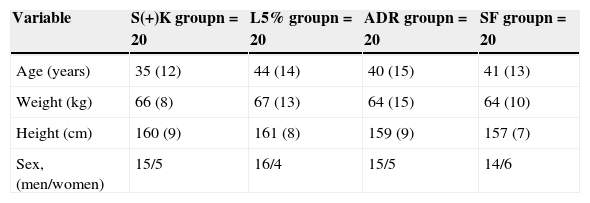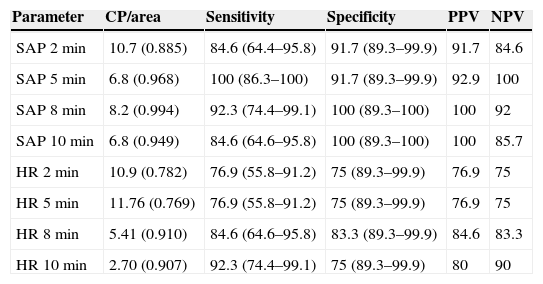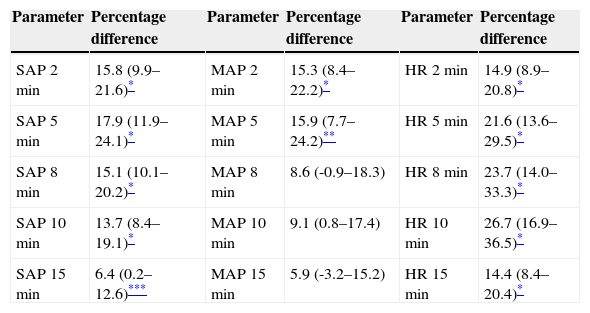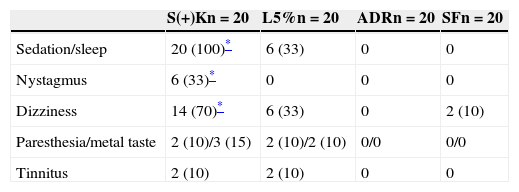The use of a test dose in epidural anesthesia is a safety recommendation. However, specificity and sensitivity of the drugs used with this indication have not been conclusive. The main objective of this study was to compare the effectiveness and the adverse effects of a simulated intravascular test dose of adrenaline, lidocaine and S(+)-ketamine.
Material and methodsA prospective, randomized, double blinded, placebo controlled study was designed. ASA I patients scheduled for elective surgery were included. These were randomized to the following study groups: S(+)-ketamine 0.5mgkg−1 (S+K group), 5% lidocaine 1.5mgkg−1 (L5% group), adrenaline 15¿g (ADR group), and physiological saline 3ml (SF group; control group).
An evaluation was made during the first 15min after the study drug was administered. Variables including heart rate (HR) systolic and diastolic blood pressure (sBP and dBP), mean arterial pressure (MAP), and SpO2 were recorded at 0min (baseline) and at 2, 5, 8, 10 and 15min after drug injection. An increase of at least 20 beats per minute (bpm) in relation to the baseline measurement was considered a positive result, as was an increase sBP >15mmHg. The clinical effects described as related to IV injection of the study drugs recorded were sedation-hypnosis, dizziness, nystagmus, metallic taste perception, perioral or facial paresthesias, tinnitus, as well as any other effect the patients mentioned. Sensitivity and specificity were calculated as was the percent increase in the parameters in order to see if these were clinically useful.
ResultsA total of 80 patients, 20 per group, were included. The sBP, dBP, and MAP were significantly raised at the 2, 5, 8 and 10min measurements in the S(+)K group compared to the rest of the groups (p<.05), as well as HR in the 2, 5, 8, 10 and 15-min measurements in the S(+)K compared to the rest of the groups (p<.05).
Sensitivity and specificity were high, and significant in the S(+)K group from minute 2 to minute 8 compared with the placebo group, as well as percentage points differences in the same interval.
There were significant differences in the incidence of sedation-hypnosis, nystagmus and dizziness, which were more frequent in the S(+)K group. There were no differences in the incidence of metallic taste, perioral and facial paresthesias or tinnitus. The effects in the S(+)K group always occurred before minute 5 after drug injection.
ConclusionBoth lidocaine and adrenaline at the scheduled doses showed low sensitivity and specificity as a simulated IV epidural test dose. S(+)-ketamine could be a feasible marker after accidental IV injection during epidural anesthesia or analgesia.
La dosis test en anestesia epidural es una recomendación de seguridad. La especificidad y sensibilidad de los fármacos empleados no ha resultado concluyente. Nuestro objetivo fue comparar la efectividad de adrenalina, lidocaína y S(+)-ketamina como dosis test intravascular simulada, así como sus efectos adversos.
Material y métodosEstudio prospectivo, aleatorizado, doble ciego, controlado con placebo. Pacientes ASA I, sometidos a cirugía electiva. Los grupos de estudio fueron (asignación aleatoria): S(+)-ketamina 0,5mg/kg−1 (grupo S+K), lidocaína 5% 1,5mg/kg−1 (grupo L5%), adrenalina 15¿g (grupo ADR) y suero fisiológico 3ml (grupo SF; grupo control).
Se evaluaron los primeros 15min tras la administración del fármaco. Se evaluó: FC, PAS, PAM, PAD y SpO2 a los 0min (basal) y a los 2, 5, 8, 10 y 15min de la inyección del fármaco de estudio. Se consideró positivo un incremento de al menos 20lat/min respecto de la determinación basal, o un incremento de la PAS>15mmHg. Se registraron efectos clínicos: aparición de sedación-hipnosis, mareo, nistagmo, percepción de sabor metálico, parestesias faciales o peribucales, tinnitus, así como cualquier otro efecto referido por los pacientes. Se calculó la sensibilidad y especificidad y la diferencia porcentual de la variación para comprobar su significación clínica.
ResultadosFueron incluidos 80 pacientes, 20 por grupo. Se encontraron diferencias significativas en la PAS, PAM y PAD que se incrementaron a los 2, 5, 8 y 10min entre el grupo S(+)K y los otros 3 grupos (p<0,05), así como en la FC a los 2, 5, 8, 10 y 15min entre el grupo S(+)K y el resto (p<0,05).
La sensibilidad y especificidad fueron altas y significativas en el grupo S(+)K comparada con placebo desde el minuto 2 al 8, así como la diferencia porcentual en ese mismo intervalo.
Hubo diferencias significativas en la incidencia de sedación-sueño, nistagmo y mareo, que fue mayor en el grupo S(+)K, pero no las hubo en la incidencia de sabor metálico, parestesias peribucales o tinnitus. Los efectos detectados en el grupo S(+)K aparecieron siempre antes de los 5min de inyectado el fármaco.
ConclusiónTanto lidocaína como adrenalina a las dosis empleadas presentaron escasa sensibilidad y especificidad como dosis test epidural intravascular simulada. S(+)-ketamina es un posible marcador de una inyección accidental intravascular.
Artículo
Comprando el artículo el PDF del mismo podrá ser descargado
Precio 19,34 €
Comprar ahora













